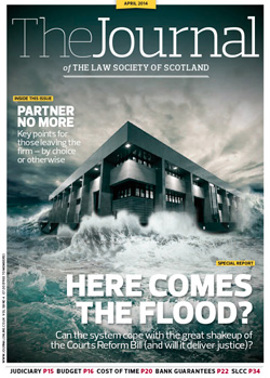Scottish banknotes: an uncertain future
As the currency debate drags on, many voters don’t know who, or what, to believe.
An analysis of current legislation and the currency debate so far provides some answers. Assuming a “Yes” campaign victory in September, Independence Day will be 24 March 2016.
George Osborne, the UK Chancellor, has ruled out a currency union with an independent Scotland. Alex Salmond, Scotland’s First Minister, says he’s bluffing. But what if he’s not?
The UK’s currency arrangements are unique and historically complicated.
Even in Scotland, Scottish banknotes are not legal tender. They are, however, “legal currency” insofar as they are issued with the permission of the UK Government and guaranteed by the Bank of England (BoE).
Scottish banknotes are issued subject to numerous Acts of the UK Parliament, most recently the Banking Act 2009, along with part 3 of the Scottish and Northern Ireland Banknote Regulations 2009.
Under existing regulations, Scottish banks are required to hold reserves of Bank of England banknotes and UK coinage, and have balances with the BoE to the same value of the Scottish banknotes issued – approximately £4 billion.
So, while it is true for the UK Chancellor to say that a “Yes” vote means walking away from a formal currency union, an independent Scotland automatically inherits an informal currency arrangement. In this regard John Swinney, the Scottish Finance Secretary, is also quite correct. There is precisely nothing UK ministers can do to stop an independent Scotland using sterling.
From a legal perspective, current legislation allows an independent Scotland to retain sterling. “Sterlingisation” is not so much the “plan B”. It is, in law, the opening negotiating position.
Currency choices
An analysis of the Scottish currency debate is equally insightful.
The Scottish Government paper Currency Choices for an Independent Scotland considers five options.
A formal currency union is the preferred choice, but George Osborne has ruled this out.
Regarding sterlingisation, the paper notes the benefits to include: no change in currency, no need for a formal agreement with the UK, and full fiscal autonomy. It also notes the “limited role for a central bank”, and the “limited opportunity to provide liquidity to the financial systems”.
Specifically, monetary policies will be set by the Bank of England, and the BoE will not be the lender of last resort to Scottish banks or the Scottish Government.
On the grounds of transaction costs, Alex Salmond has effectively ruled out three options: a new Scottish currency pegged to sterling, a new floating Scottish currency, and joining the euro.
From the public debate thus far, the politicians, between them, have therefore ruled out all options with the exception of sterlingisation.
Consequences
But, there is a complication with sterlingisation.
With independence, the Bank of England would lose its role as guarantor. Consequently, on Independence Day, today's Scottish banknotes would cease to be legal currency. They could, technically, stay in circulation as “alternative currency” – a unique proposition. Other common examples of “alternative currency” include book tokens and casino chips.
Today, every sovereign state uses either legal tender or legal currency. Some states, however, use foreign currency as their legal currency. Panama, for example, uses the US dollar as its legal currency.
Beyond this, there is the banking consideration. Figures from the Scottish Government website show that Scottish banking assets as at May 2013 total some £1.89 trillion, or 1,254% of Scotland’s GDP. Given the size and standing of the banking sector, is an “alternative currency” option credible?
Indeed, the three Scottish banks which issue their own banknotes may not wish to participate in such a unique proposition involving the large scale use of “alternative currency”.
And, rule 10 of the Scottish and Northern Ireland Banknote Rules allows the banks to cease issuing their own banknotes after giving the Bank of England three months’ notice. There is no need for political approval, north or south of the border.
This means, in effect, that the banks can implement sterlingisation unilaterally by withdrawing their own banknotes and replacing them with their BoE banknotes, which are currently held in their vaults.
Further, and with regard to the banks, it should be noted that an “alternative currency” option is not considered in the Scottish Government’s “Currency Choices for an Independent Scotland” paper.
Which again leaves sterlingisation, with BoE banknotes, as an independent Scotland's legal tender.
Irony aside, both the UK Chancellor and the Scottish First Minister may be unhappy at this prospect. Indeed, this is the political issue politicians on both sides have been avoiding.
And this, I suspect, explains the Scottish currency debate deadlock.
In this issue
- Scottish banknotes: an uncertain future
- Abolition of all guardianship and mental health laws?
- Attack vectors into the law: phishing
- End of the loan?
- Estate handling, Irish style
- Reading for pleasure
- Opinion: Fiona Woolf
- Book reviews
- Profile
- President's column
- User feedback sees results
- Court reform: does it add up?
- Diverse perspectives
- Countdown to the devolved taxes
- Rewards for the virtuous
- Moving times
- Profitability north and south of the border
- Silence is golden
- Risk assessments and OLRs
- One for the board
- Reshaping history
- Good linking
- Scottish Solicitors' Discipline Tribunal
- People on the move
- A happy marriage?
- Fair Exchange?
- Premium result
- Clients: on good terms?
- Teasing out Taylor
- The law - it's just mental
- Gold dust data
- Ask Ash
- Pritchard Trust applications invited
- From the Brussels office
- Law reform roundup
- SYLA does EYBA - proud






